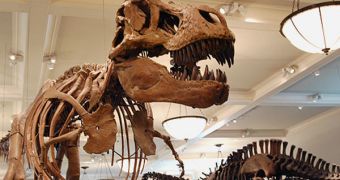Despite recent controversies on the actual sizes of dinosaurs, the fact that they were the largest animals to ever inhabit the Earth remains undisputed. Anthropologists and biologists have attempted to discover the reason why they grew so big for a long time, and also what factors favored such a large size, which was clearly unsustainable in the long run. According to a new scientific model, recently made public, it could be that the giant lizards actually used more of their internal energy for growing, rather than for keeping their bodies warm. And this would make sense, considering the vast amounts of food, and the type of metabolism they needed in order to be that big and remain warm-blooded.
The model especially focused on sauropods, which were the largest of the dinosaurs. According to estimates, they could grow to weigh as much as 60 tons, about six times more than the African elephant, which is the largest creature to roam the land today. Experts have known for a long time that vertebrates adjust their size according to two very important factors – the amount of food that is available in their environment, of which they need impressive amounts to sustain large sizes, and also the way they divide their energy, between growing and keeping themselves warm.
University of Florida Paleontologist Brian K. McNab says, for example, that African elephants can afford to be this large because they feed off grass, which can be found virtually anywhere. Conversely, hummingbirds and bees are smaller because they only feed off the nectar of plants, which can be found in relatively low supplies, and is also rather difficult to extract. Additionally, because birds and mammals are warm-blooded, their bodies need to be kept at a constant, optimum temperature, which requires large amounts of energy to achieve, and also a high metabolic rate to sustain.
However, this line of reasoning does not apply to lizards, of which the dinosaurs were part too, because these creatures rely on their environment for heat. This means that, depending on their surroundings, the internal temperature will fluctuate, without any adverse effect on the animal itself. Therefore, if a dinosaur was cold and needed to warm up, it only needed to travel to an area where the sunlight fell on it directly. On the other hand, if it needed to cool down, the shadow was the place for it.
“I think it was impossible for [dinosaurs] to have really high metabolic rates like mammals and birds, simply because the resources weren't there. How is it that dinosaurs got larger than mammals if the resources were either equal to or poorer than today? My argument is, it's because they took most of the energy they consumed and put it into growth rather than into maintenance of a high body temperature,” McNab explains, quoted by LiveScience.
“When you’re that big, you can’t cool off rapidly like a small lizard will. You have a large volume, and you have comparatively small surface area. And so if you’re warm, you’re going to stay warm, unless something unforeseen happens,” the expert adds, in a study published in the July 6th online issue of the journal Proceedings of the National Academy of Sciences (PNAS).

 14 DAY TRIAL //
14 DAY TRIAL //